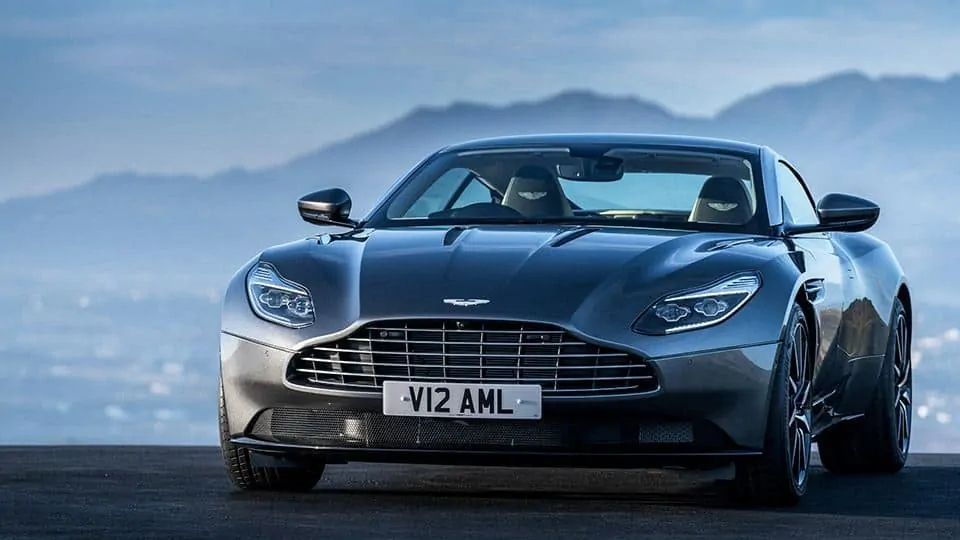It’s not every day that a new Aston Martin is unveiled. In fact, it’s been 13 years since the range-topping DB9 made its debut in 2003. The sweeping, elegant Henrik Fisker design has held up well over time, but it was clearly time for a replacement.
The DB11 (the DB10 is an exclusive model reserved for James Bond) therefore signals a new chapter in Aston Martin’s history as well as the first look at the company’s new design language built upon a new lighter, stronger, and more space efficient bonded aluminum structure.
Chief designer Miles Nurnberger told us “progressive” was the keyword in the design program, with designers looking at new ways to move the brand’s defining characteristics forward into the future while preserving the quintessential Aston Martin design flavor. The process took just under four years.
At the front, the iconic Aston Martin grille has been given a new lease on life with a subtle forward cant reminiscent of a shark nose element seen on vehicles from the company’s illustrious bloodline. Flanked by distinctive LED headlamps, the front end’s pièce de résistance is without a doubt the car’s single piece aluminum clamshell hood, which covers the entire front end and abolishes unsightly shutlines.
In profile, the car’s body tapers in from the A-pillars to the rear edge of the door, providing a ‘Coke bottle’ plan view shape and accentuating the proud and powerful haunches at the rear of the car. The roof’s cant rails flow uninterrupted from A-pillar to C-pillar, gaining in thickness before culminating just short of the base of the roofline.
Playing up to the increasingly apparent personalization trend, there are three different cant rail treatments on offer: body color, black, or a brushed aluminum finish similar to those first seen on the Aston Martin DBX crossover concept revealed at the Geneva motor show last year.
It’s a smart move. Nurnberger says there is an even split between the different styles amongst DB11 customers.
The DB11 also makes a big leap forward in terms of technological advancement, particularly with regard to aero functions. Functional side strakes — inspired in part by the CC100 concept created to celebrate the company’s centenary — integrated into the front wheel arch serve to pull hot air away from the thundering twin-turbocharged 5.2-liter V12 engine under the hood and out of the front wheel wells to cool the brakes.
The extracted air is guided out along the car’s flanks to improve aerodynamic performance and reduce drag while rear intakes within the C-pillars channel air through the trunk and out of the decklid to optimize downforce at the rear.
Aston Martin has two new patents for these aerodynamic solutions.
The rear end design is a thoroughly contemporary execution of Aston’s familiar design theme, with subtle details further accentuating the technological approach of the exterior design. Nestled within the rear valance and on either side the exhaust outlets are perforations, similar to those found in the interior.
“We didn’t want to go for the obvious solution,” says Nurnberger.
Characteristic wing-shaped taillamps are held together by a light bar at the top running the width of the decklid while a central cheater panel element within makes the lamps sink in to the body to create a new, contemporary down-road-graphic.
The interior also has a familiar identity, though the center stack has been placed further forward than the waterfall element of the DB9 and the switchgear is now sourced from Aston Martin’s partnership with Daimler rather than Ford.
There are multiple interior combinations for color, patterns, perforations and wood, as well as six specifically defined interior environments tailored by members of the Aston Martin design team. From calming tones to sharp contrasts in hue and texture, the choices are virtually limitless; every option can be selected individually to cater to a customer’s personal taste.
Nexus quilting and Celestial perforation on the seats and headliner add layers of complexity while ornate leatherwork, such as intricate brogue detailing, create areas of visual and tactile delight. Fine quality materials and hand craftsmanship are clearly Aston Martin hallmarks.
Buyers looking for cutting edge technology will not be left wanting. An all-new full-color 12-inch TFT LCD instrument cluster directly in front of the driver presents primary vehicle information, while a second, 8-inch TFT screen at the center of the IP dedicated to infotainment is controlled via an intuitive rotary control, with an optional touchpad offering character recognition, multi-touch and gesture support.
Also operated via the car’s infotainment system is a new auto-park assist feature and 360-degree ‘bird’s-eye view’ camera to ensure safe maneuvering at slow speeds.
As the first product launched under the company’s ‘Second Century’ plan, DB11 heralds a new, sharper and more technologically expressive design that follows the company’s illustrious bloodline. It is the next step in a legacy that includes icons such as the DB2/4, DB5 and DB7.
It is an evolution of the authentic, sporting Grand Tourer and one undeniably worthy of the Aston Martin nameplate.


















